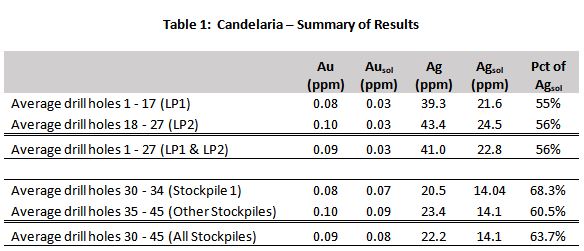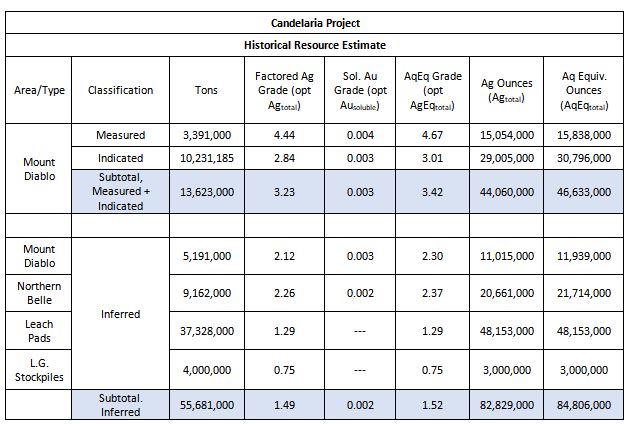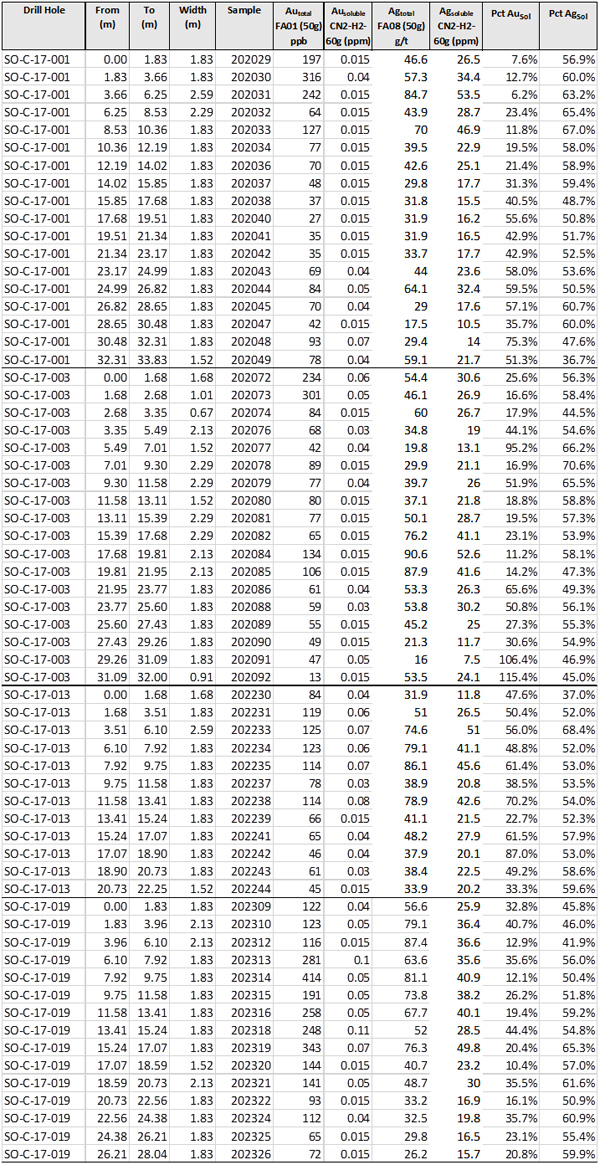Related Document
Vancouver, BC, April 19, 2018 - Silver One Resources Inc. (TSXV: SVE; OTC Pink: SLVRF; FSE: BRK1 - “Silver One” or the “Company”) has received encouraging assay results from the previously announced sonic drilling conducted on the leach pads, stockpiles and dumps on its 100% controlled Candelaria project in Nevada (see news release from November 28, 2017). Additionally, Silver One has submitted samples for metallurgical testing to evaluate the economics for recovery of silver and gold, based on the positive analytical results received.
Greg Crowe, President and CEO of Silver One Resources commented, “The results to date are encouraging as the head grade of the leach pads, estimated at 43 g/t, is over 3 times greater than the head grades currently being mined at the Rochester Mine held by Coeur Mining approximately 220 kilometres north of Candelaria. Further, an average cyanide silver content of 56% for leach pad material and 64% for fresh material in stockpiles, combined with their respective silver grades reported, provide a very promising outlook for the project.
Historic silver recoveries at Candelaria ranged from 42% to 51% of the total silver through the heap leaching ores crushed at sizes below 1 inch. We believe that such recoveries may be improved by milling prior to leaching. The next step is to conduct metallurgical testing and the composite samples are now in the lab. We look forward to receiving metallurgical results to evaluate the economics for recovering silver and gold at Candelaria.”
Candelaria Drill Program Highlights:
- A total of 27 holes were drilled on two historic leach-pads (LP1 and LP2), 16 holes on stockpiles and two holes on dumps.
- Assays were done on 730 samples, including 590 core samples and 140 standards, duplicates and blanks.
- All holes were sampled in their entirety. Samples average 1.88 metres in length representing a total of 1,110 metres drilled.
- Total silver assays in leach pads range from 16 g/t to 111 g/t (41 g/t average).
- Cyanide soluble silver in leach pads range from 35% to 77% (56% average).
- Total gold assays in leach pads range from 0.017 g/t to 0.75 g/t (0.09 g/t average).
- Cyanide soluble gold in leach pads range from 3% to 100% (37% average).
- Total silver and gold in stockpiles averages 22.2 g/t and 0.08 g/t respectively.
- Cyanide soluble silver and gold in stockpiles average 64% and 89% respectively.
- Total silver in dumps varies from 1 g/t to 27 g/t (5 g/t average).
The results above are consistent with previous averages reported for the leach pads, which range between 39 g/t and 48 g/t Ag. The first average, is the average of samples collected on shallow pits dug on the surface of the leach pads by Silver One in December 2017 and the second, obtained from SSR Mining Inc. (“SSR” - TSX: SSRM; NASDAQ: SSRM – formerly Silver Standard Resources Inc.) by re-assaying pulps of 10 drill holes drilled by Kinross Gold Corp. (TSX: K; NYSE: KGC) in 1992. Similarly, the average silver grade of 25 g/t in stockpiles reported by the National Instrument 43-101 (“NI 43-101”) technical report filed by SSR in 2001 titled “Candelaria Project Technical Report”, is in line and statistically similar to the average of 22.2 g/t Ag obtained by the results of the Silver One sonic drill program.
Additional Assay Results and Drilling Details
A summary of relevant average results of the assays of sonic drill holes are shown below in Table 1. All samples of each drill hole are included in the average. Additional assay results showing individual samples are included in Appendix A.
Drilling was conducted on a 200-metre spacing rectangular grid with a hole in the center (providing a nominal spacing of 141 metres to 200 metres between drill holes) on LP1, on a 100 metre grid in LP2, and on a 50 to 75 metre spacing grid on the stockpiles as shown in the figure set forth in Appendix B.
All drill holes are 6-inch core holes drilled with a sonic rig and are vertical with variable depth between 1.5 metres to 96.6 metres. Sample intervals average 1.88 metres. Individual samples range from 0.6 metres to 3.96 metres all being true widths.
Quality Control and Quality Assurance (“QA/QC”)
Silver One follows a systematic and rigorous QA/QC program overseen by Greg Crowe, President & CEO and a Director of Silver One.
The Company inserts certified standards, duplicates and blanks for 20% of the total samples submitted to the laboratory for analysis. All samples collected were dried, split and assayed by Skyline Labs in Tucson,
Arizona, USA (ISO 17025 Laboratory Competence Certification: 2005) for cyanide soluble silver, total silver, multi-element assay and fire assay gold as follows:
- FA-01-50 - Silver by atomic absorption “AA” with aqua regia digestion, 50 gram sample.
- CN-2H-60 – Gold-silver cyanide soluble with 2-hour cyanide shake and AA assay, 60 gram sample.
- FA-1-50 - Gold fire assay with AA finish, 50 gram sample.
- TE-5 - Multi-element assay, 4-acid digestion.
- Over limits of silver and gold were further analyzed by fire assay – gravimetric, 50 gram sample.
As part of its standard operating procedures, the laboratory also inserts certified blanks, standards and includes duplicate analyses.
Metallurgical Testing
Seven composite samples have been prepared and sent to McClelland Laboratories, Inc. in Reno, Nevada for metallurgical testing. The metallurgical results will assist in determining the best methods to potentially recover silver from the heap leach pads, stockpiles and dumps.
Extensive metallurgical work was conducted by SSR between 1998 and 2001 which tested recovering silver in leach pads by cyanidation or flotation alone, and flotation combined with cyanidation among others. The conclusion was that the best cost/benefit alternative was the optimization of cyanidation conditions of the cyanide leach process.
Results of preliminary cyanide bottle-roll tests conducted by the Company in December 2017 on samples collected near-surface on the leach pads, show recoveries between 15% to 20% of the total silver for material crushed to 1.7 millimetres (10 mesh). Reagents consumption was very low indicating that the cost of leaching the crushed material would be relatively inexpensive. Recoveries however, may be improved by milling prior to leaching. Therefore, current metallurgical testing is focused on evaluating milling-leaching scenarios. Further analyses of the samples will consist of additional bottle-roll tests at various finer fractions (-10, -65 and -200 mesh) using cyanide and ammonium thiosulfate. Results are expected by Q3 2018.
Resource Update
Silver One has engaged Jim McCrea, an independent consultant to prepare a current NI 43-101 resource estimate on the leach-pads and stockpiles. The Company anticipates that the resource estimate will be completed by the end of Q3 2018.
Candelaria was historically the highest-grade silver producer in the state of Nevada, averaging over 1,200 g/T AgEq (40 oz/t AgEq) from high-grade vein mining between the mid-1800s and the mid-1900s. Open pit mining operations were undertaken in the 1970s through 1998 by several companies, including Nerco, Inc. and Kinross. Kinross closed the open pit and leach operation in 1998 due to low silver prices. Leaching of the historic pads was not completed leaving a substantial amount of silver unprocessed. It is estimated that the property has produced over 68 million ounces of silver. Historical information was obtained from “Geology of the Candelaria Mining District, Mineral County, Nevada, 1959, Nevada Bureau of Mines, Bulletin 56”, and the SSR Mining Inc. technical report titled “Candelaria Project Technical Report” dated May 24, 2001 (filed on SEDAR June 20, 2002), prepared by Pincock Allen & Holt.
Historical Resource Estimate – Candelaria Project, Nevada
SSR Mining Inc. acquired the Candelaria Project in 2001 and reported in a technical report titled “Candelaria Project Technical Report” dated May 24, 2001 (filed on SEDAR on June 20, 2002), prepared by Pincock Allen & Holt, the historical mineral resource estimate shown in the table below.
Notes:
- Lode resources tabulated at a 0.5 opt Agsoluble cut-off grades, with only Agtotal shown in this table
- Leach pads and low-grade stockpile resources tabulated for entire accumulation of material.
- Total silver grades factored from soluble silver grades using regression formulas developed by Snowden.
- Silver equivalent grade includes the contribution from the gold grade (soluble) using an Ag:Au equivalency ratio of 57.8:1.
The historical mineral resource estimate used “measured mineral resource”, “indicated mineral resource” and “inferred mineral resource”, which are categories set out in NI 43-101. Accordingly, Silver One considers these historical estimates reliable as well as relevant as it represents key targets for exploration work by Silver One. The data base for the historical resource estimate:
(1) Mount Diablo Deposit - Consisted of 538 drill holes by previous owners and 10 drill holes by SSR. For drill holes that were twinned, the author used the lower of the two values assigned to the original holes. The mineral resource estimate used a kriging estimation method to establish ore zones with a cut-off grade of 0.5 opt Ag. Ordinary kriging was used to interpolate grades in the block model. The block models were set up with block dimensions of 25 feet by 25 feet in plan and 10 feet in height. The maximum search range used in the higher-grade zone was 235 feet, in the lower grade zone it was 1,000 feet and in the background zone it was 350 feet. Block models more than 300 feet from the nearest composite only constituted 3 percent of the total number of estimated blocks and were assigned to an inferred category;
(2) Northern Belle Deposit - Consisted of 226 drill holes by previous owners, of which a portion of these holes were duplicated for the Mount Diablo Deposit database. The mineral resource estimate used a kriging estimation method to establish ore zones with a cut-off grade of 0.5 opt Ag. The mineral resource estimate used multiple indicator kriging to interpolate grades in the block model. Block models were set up with block dimensions of 50 feet by 50 feet in plan and 20 feet in height. The maximum search range used in the higher-grade zone was 85 feet, in the intermediate-grade zone was 120 feet and the lower-grade zone was 140 feet and in the lower undifferentiated material below the current pit topography was 260 feet. Block models more than 300 feet from the nearest composite only constituted 3 percent of the total number of estimated blocks and were assigned to an inferred category;
(3) Leach Pads - Consisted of 24,633,000 tons located on Leach Pad 1 and 12,695,000 tons on Leach Pad 2. The estimate for Leach Pad 1 is based on silver production indicates 51.5% of total silver was recovered by heap leaching operation, while 81.2% of the soluble silver contact was recovered. Further, the estimate for Leach Pad 2 is based on silver production indicates 42.4% of total silver was recovered by heap leaching operation, while 71.3% of the soluble silver content was recovered;
(4) Low-Grade Stockpile - Based on limited and incomplete data and documentation. Material placed on the stock piles ranged from 0.5 to 0.65 opt Ag.
The qualified person has not done sufficient work to classify the historical estimate as a current mineral resource. Silver One is not treating this historical estimate as current mineral resources.
Qualified Person
The technical content of this news release has been reviewed and approved by Greg Crowe, P.Geo, President and CEO of Silver One, and a Qualified Person as defined by NI 43-101
About Silver One
Silver One is a silver-focused exploration company that holds an option to acquire a 100% interest in the past producing Candelaria Silver Mine Project, located in Nevada, from SSR Mining Inc. and a 100% interest in three significant silver assets located in Mexico: Penasco Quemado in the State of Sonora, La Frazada in the State of Nayarit, and Pluton in the State of Durango. The mining assets in Mexico were acquired from First Mining Gold, which is a key shareholder of Silver One resulting from the transaction.
For more information, please contact:
Silver One Resources Inc.
Monica Hamm
VP, Investor Relations
Phone: (604) 974‐5274
Email: mhamm@silverone.com
Forward-Looking Statements
Information set forth in this news release contains forward-looking statements that are based on assumptions as of the date of this news release. These statements reflect management’s current estimates, beliefs, intentions and expectations. They are not guarantees of future performance. Silver One cautions that all forward looking statements are inherently uncertain and that actual performance may be affected by a number of material factors, many of which are beyond Silver One’s control. Such factors include, among other things: risks and uncertainties relating to Silver One’s limited operating history, ability to obtain sufficient financing to carry out its exploration and development objectives on the Candelaria Project, obtaining the necessary permits to carry out its activities and the need to comply with environmental and governmental regulations. Accordingly, actual and future events, conditions and results may differ materially from the estimates, beliefs, intentions and expectations expressed or implied in the forward-looking information. Except as required under applicable securities legislation, Silver One undertakes no obligation to publicly update or revise forward-looking information.
NEITHER TSX VENTURE EXCHANGE NOR ITS REGULATION SERVICES PROVIDER (AS THAT TERM IS DEFINED IN THE POLICIES OF THE TSX VENTURE EXCHANGE) ACCEPTS RESPONSIBILITY FOR THE ADEQUACY OR ACCURACY OF THIS RELEASE.
Appendix A - Assay results of selected sonic drill holes drilled on leach pads at the Candelaria project
Appendix B - Location of sonic drill holes on Candelaria project





